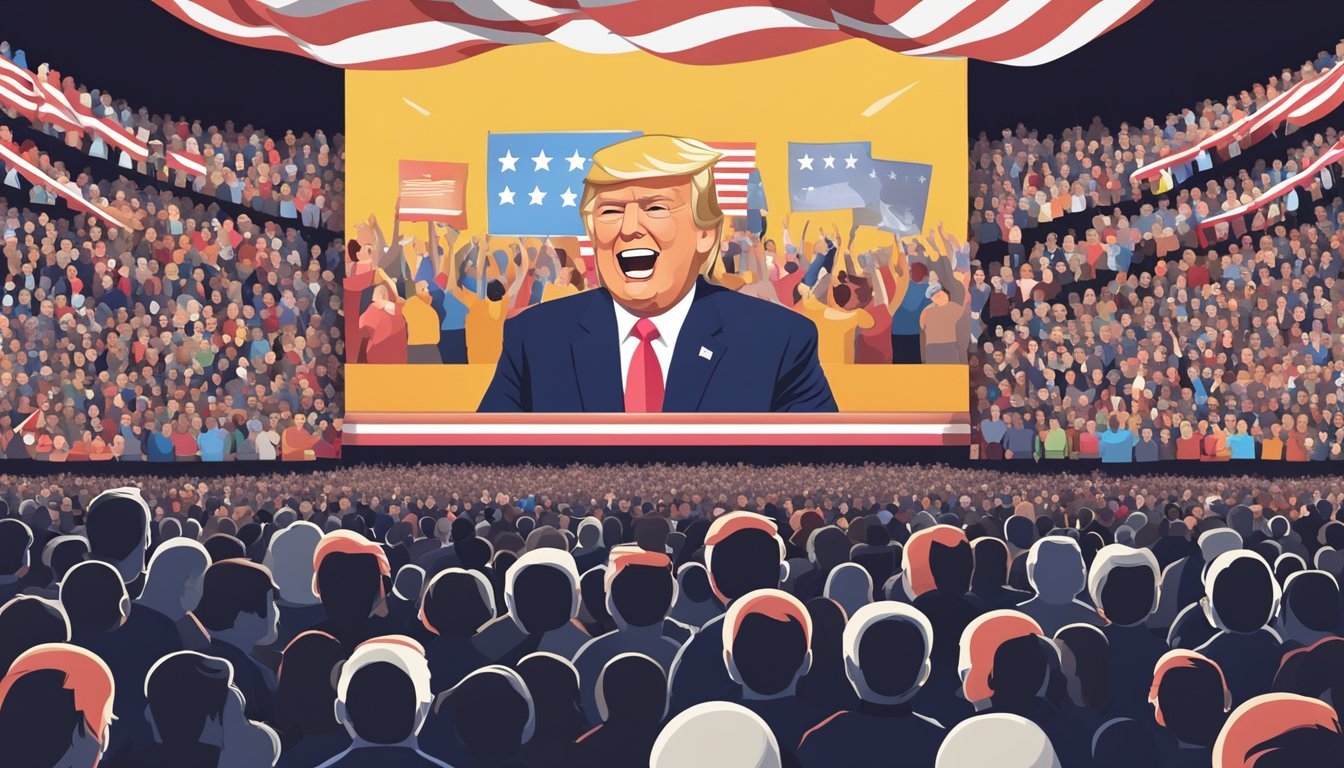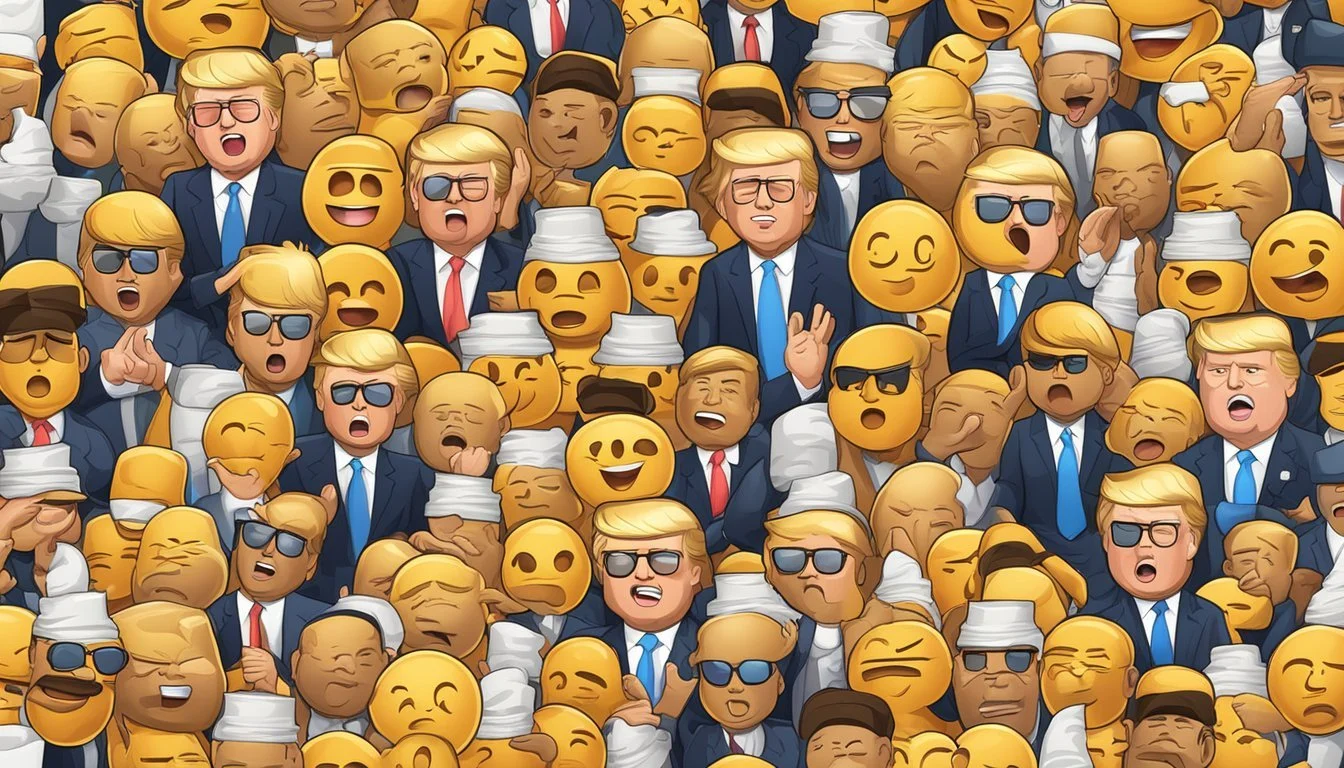Digital Icon Captures Presidential Likeness
New Addition to Political Discourse on Social Media
Donald Trump emojis have become a popular way for people to express themselves online and in messaging apps. These digital icons capture the essence of the former U.S. president's distinctive facial expressions, hairstyle, and mannerisms. Trump emojis range from simple cartoon-style faces to more detailed designs featuring his signature gestures and catchphrases.
Various apps and platforms offer Trump emoji collections for users to download and use. Some collections focus on Trump's political career, featuring emojis related to his campaign slogans, policy positions, and memorable moments from debates and speeches. Others take a more lighthearted approach, depicting Trump in humorous or exaggerated ways.
The popularity of Trump emojis reflects the former president's outsized impact on popular culture and political discourse. Whether used to show support, criticism, or simply to add humor to conversations, these digital icons have become a unique form of political expression in the age of social media.
Origins of Donald Trump Emojis
Donald Trump's unique persona and communication style sparked the creation of custom emojis representing him. These digital icons emerged as a cultural phenomenon, reflecting public perceptions and political discourse surrounding the controversial figure.
Historical Context
The rise of Trump emojis coincided with his 2016 presidential campaign. As social media played a crucial role in political discussions, users sought new ways to express their views on Trump. Emoji creators responded by designing icons featuring Trump's distinctive hairstyle and facial expressions.
Early Trump emojis often exaggerated his physical features, such as his signature blonde hair and pursed lips. Some depicted him in various poses or with campaign slogans like "Make America Great Again." These emojis quickly spread across platforms like Twitter and Facebook.
Rise in Popularity
Trump emojis gained traction as his political presence grew. The pouting face emoji became unofficially associated with Trump, according to an analysis of 10 million inauguration-related emoji responses. This connection highlighted the public's perception of his demeanor.
As "Trumpisms" entered popular culture, emoji creators incorporated his catchphrases and mannerisms into new designs. The phrase "Make Emojis Great Again" emerged as a playful spin on his campaign slogan.
• Most popular Trump emojis:
Pouting face 😡
American flag 🇺🇸
Blonde hair man 👱♂️
Trump emojis evolved to represent specific events or controversies throughout his presidency, serving as visual shorthand in online political discourse.
Types of Trump-Related Emojis
Trump-themed emojis and stickers have become popular ways for supporters and critics alike to express their views. These digital icons range from depictions of Trump's face to reaction emojis associated with his statements and policies.
Trump Face Emojis
Trump face emojis typically feature caricatures of the former president's distinctive appearance. Many highlight his blonde hair, tan complexion, and animated expressions. Some show Trump with a raised fist or giving a thumbs up - gestures he often uses at rallies.
Popular variations include "MAGA Trump" with a red cap, "Angry Trump" with an exaggerated scowl, and "Smug Trump" with a self-satisfied grin. These emojis allow users to quickly convey Trump-related sentiments in digital conversations.
Trump Stickers and Trumpoji
Beyond basic face emojis, more elaborate Trump stickers and "Trumpojis" offer additional ways to reference the former president. These often incorporate Trump catchphrases like "You're Fired!" or "Make America Great Again."
Some Trumpojis depict full-body caricatures of Trump in various outfits and poses. Others show Trump engaged in activities like golfing, tweeting, or giving speeches. Many of these stickers aim for humor, exaggerating Trump's mannerisms and appearance.
Angry Faces and Reactions
Emojis expressing anger, frustration, or disapproval have become associated with discussions about Trump and his policies. The red angry face emoji is frequently used by Trump critics to react to his statements.
Other common reaction emojis in Trump-related conversations include the facepalm, eye roll, and thinking face. These allow users to quickly convey skepticism or disagreement. Trump supporters may use positive emojis like the applause hands or American flag in response to his messages.
Cultural Impact and Usage
Emojis have become a significant part of digital communication, particularly in relation to political figures like Donald Trump. Their use has expanded beyond simple expressions to convey complex political sentiments and reactions.
In Media and Online Communication
The toilet emoji emerged as an unexpected symbol associated with Donald Trump in online discourse. Social media users creatively repurposed this emoji to express criticism or disapproval of Trump's actions and statements. This usage spread rapidly, demonstrating how a single emoji can convey nuanced political commentary.
Emoji keyboards expanded to include more politically-themed options during Trump's presidency. Users embraced these new emojis to react quickly to news and events. The pouting face emoji became widely recognized as an unofficial representation of Trump himself.
Political Expression through Emojis
Emojis served as a shorthand for complex political opinions during Trump's time in office. Supporters and critics alike used specific combinations of emojis to signal their stance on various issues. This form of expression allowed for swift, visual communication of political alignment.
The use of emojis in political contexts varied across cultures. In some countries, certain emojis took on different meanings when used in relation to Trump or American politics. This highlighted the importance of cultural context in interpreting emoji usage in global political discussions.
Technical Aspects of Donald Trump Emojis
Donald Trump emojis incorporate distinctive visual elements and are available through specialized emoji keyboards. These digital representations aim to capture Trump's likeness and iconic features for use in text-based communication.
Design and Characteristics
Trump emojis typically feature exaggerated facial features, including his signature hairstyle and facial expressions. The most common designs showcase his blonde hair, pursed lips, and squinting eyes. Some versions include additional elements like a red tie or a "Make America Great Again" cap.
Color palettes for Trump emojis often use flesh tones, yellow for hair, and red for accessories. Designers pay close attention to details like wrinkles and facial contours to enhance recognition.
Animated Trump emojis exist as well, incorporating movements like head shaking or finger pointing. These GIF-style emojis add an extra layer of expressiveness to digital conversations.
Emoji Keyboards for iOS Users
iOS users can access Trump emojis through third-party keyboard apps. These specialized keyboards offer a range of Trump-themed emojis and stickers. Popular options include "Trump Emoji" and "MAGA Emojis."
To install, users download the app from the App Store and enable it in their device settings. Once activated, the Trump emoji keyboard appears alongside the standard iOS keyboard.
These keyboards often include categories like "Facial Expressions," "Gestures," and "Quotes." Users can easily insert Trump emojis into messages, social media posts, and other text fields.
Some apps offer customization options, allowing users to create personalized Trump emojis or combine existing ones with text overlays.
Acquisition and Accessibility
Donald Trump emoji are available through select digital platforms and app stores. Their distribution is subject to licensing agreements and platform policies.
Availability in the Apple Store
The Apple Store offers a limited selection of Donald Trump emoji through certain approved third-party keyboard apps. Users can download these apps to access Trump-themed stickers and emoji. Some popular options include "Trump Emojis" and "MAGA Stickers." These apps typically require iOS 11.0 or later and are compatible with iPhone, iPad, and iPod touch.
Apple's review process for emoji apps can be stringent, impacting the approval timeline for Trump-related content. The availability of these emoji may fluctuate based on current events and App Store guidelines.
Licensing and Distribution
Licensing for Donald Trump emoji varies depending on the creator and distributor. Official campaign merchandise often includes proprietary emoji designs, which are protected by copyright laws. Third-party developers must obtain proper permissions to use Trump's likeness in their emoji products.
Distribution channels include social media platforms, messaging apps, and specialized emoji keyboards. Some platforms have implemented policies regarding political content, potentially affecting the widespread distribution of Trump emoji.
Developers may face challenges in navigating the complex landscape of political imagery and trademark considerations when creating and distributing Trump-themed emoji.
Conclusion
Donald Trump's use of emoji has left a lasting impression on digital communication in politics. His occasional inclusion of emojis in tweets sparked widespread reactions and discussions.
The "Trumpoji" phenomenon emerged as supporters and critics alike created custom emoji sets inspired by the former president. These ranged from cartoonish depictions to more realistic portrayals.
Emoji responses to Trump's inauguration provided unique insights into public sentiment. Millions of emoji reactions were analyzed to gauge emotions and opinions surrounding the event.
Trump's winking face emoji in a tweet about the stock market exemplified his unconventional approach to presidential communication. It blurred the lines between formal and informal discourse on social media.
The use of emoji in politics continues to evolve. While some view it as a way to connect with younger voters, others argue it diminishes the gravity of important issues.
Ultimately, Trump's emoji usage highlighted the changing landscape of political communication in the digital age. It demonstrated the power of simple symbols to convey complex messages and evoke strong reactions.







